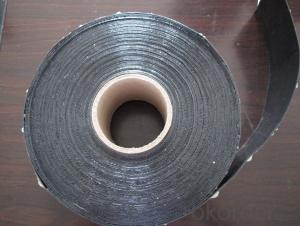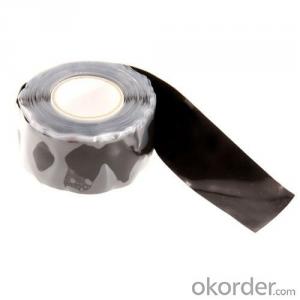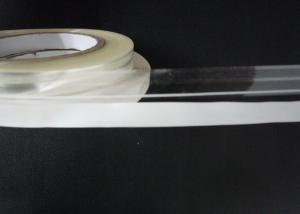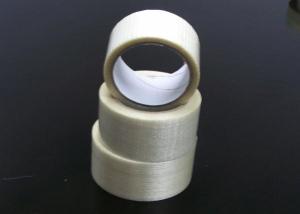Economical Freezer Grade Self-Adhesive Aluminum Waterproof Tape
- Loading Port:
- China Main Port
- Payment Terms:
- TT OR LC
- Min Order Qty:
- -
- Supply Capability:
- -
OKorder Service Pledge
OKorder Financial Service
You Might Also Like
Specifications
self-adhesive aluminum waterproof tape:
1)acrylic rubber modified butuminous.
2)very economical.
3)easy to apply.
4)waterpro
Features of Aluminum waterproof Tape :
1)Very easy to apply
Very economical
Water-proof
Self-adhesive
Can be over-painted
Very good performance in UV-resistance
Good adhesion to many substrates
2)Shelf Life
120 month from date of production if stored in unopened,undamaged original sealed containers,in dry conditions and protected from direct sunlight at temperatures between +5°C and +60°C.
3)colours:Tape available in two different colours:
--Upper side:Painted aluminium foil,in mat .
--Lowerside:Self-adhesive black bituminous tape protected with a release PE membrane.
4)
---Service Temperature
-20°C~70°C
---Tensile Strength: ≥450/5cm
---Elongation at Break: ≥130 N/5cm
(Physics capability reference No. JC840 1999)
Applications:
a)Protection:Asphalt,brickwork,concrete,fiber cement sheet,metal and plastic materials,roofs and covering etc.
b)Sealing and waterproofing:
Glass & plastic windows frames,parapets,skylight structures etc
Repair work : metal and fiber cement sheet roofing,shingles,gutters and metal tube etc
Directions:
Surface must be clean,dry and free of dirt,grease,oil or water.
remove and release paper and press it into position using fingertip pressure.
Use a seam roller to smooth over the self-adhesive aluminum waterproof tape to ensure good contact is made.
- Q: Can packaging tape be used for bundling items together?
- Yes, packaging tape can definitely be used for bundling items together. It is commonly used to secure and hold multiple items together, especially when shipping or moving. Packaging tape is designed to be strong and reliable, providing a secure hold that keeps items bundled tightly. It is often used to bundle boxes, packages, or other items that need to be kept together during transportation or storage.
- Q: How does the tape used for packing the finished product in the workshop be accounted for?
- Bank deposits (or accounts payable, etc.)Lead in:The cost of production (or manufacturing expense)Revolving material - packaging
- Q: Does packaging tape come in different allergen-free options?
- Yes, packaging tape is available in various allergen-free options. Many manufacturers offer packaging tapes that are specifically designed to be hypoallergenic and suitable for individuals with allergies or sensitivities. These tapes are typically free from common allergens such as latex, gluten, and certain chemical irritants. It is important to check the product description or contact the manufacturer to ensure that the packaging tape meets your specific allergen-free requirements.
- Q: Can packaging tape be used on different materials?
- Yes, packaging tape can be used on different materials. Packaging tape is versatile and can adhere to a wide range of surfaces, including cardboard, plastic, metal, glass, and even fabric. It is designed to provide a strong and secure seal, ensuring that packages remain intact during transportation and storage. Whether you are sealing a cardboard box, bundling items together, or securing a package, packaging tape is an effective choice for various materials.
- Q: Can packaging tape be used for sealing construction or building materials?
- Indeed, packaging tape possesses the capability to seal construction or building materials. Although it lacks the endurance and strength found in specialized construction tapes, packaging tape can serve as a temporary or expedient remedy for sealing materials like cardboard, plastic sheets, or lightweight panels. It is suitable for fastening interim covers, affixing protective layers, or keeping materials secure throughout construction or renovation endeavors. Nevertheless, for extended or demanding applications, it is advisable to opt for tapes explicitly engineered for construction, as they exhibit superior resistance against weather, UV rays, and possess enhanced adhesive properties.
- Q: Is packaging tape waterproof?
- Yes, packaging tape is typically waterproof. It is designed to provide a secure seal and protect packages from moisture and other external factors during transit or storage.
- Q: Is packaging tape safe for use on painted surfaces or walls?
- Packaging tape is generally safe for use on painted surfaces or walls. However, it is important to exercise caution and follow proper techniques to minimize any potential damage. When applying packaging tape on painted surfaces or walls, it is recommended to test a small, inconspicuous area first to ensure that the tape does not peel off or damage the paint. Additionally, it is advisable to remove the tape gently and slowly to avoid any paint peeling or residue left behind. If the paint is delicate or the tape has been left on for an extended period, there is a possibility that the tape may cause some minor damage, such as slight paint discoloration or removal. Therefore, it is always a good idea to handle packaging tape with care and take necessary precautions to protect the painted surfaces or walls.
- Q: Can packaging tape be used for sealing sports equipment or gear?
- Indeed, sports equipment or gear can be sealed using packaging tape. With its robust adhesive properties, packaging tape proves to be an excellent choice for securing and sealing a range of items, including sports equipment. By securely fastening the equipment and gear, it effectively safeguards them against potential damage when being transported or stored. Nonetheless, it's crucial to take into account the unique demands and specifications of the sports equipment or gear being sealed, as certain items may necessitate specialized tapes or sealing techniques to ensure optimal protection.
- Q: Can packaging tape be used for sealing gardening or outdoor equipment?
- Indeed, gardening or outdoor equipment can be effectively sealed using packaging tape. Specifically engineered to securely seal boxes and packages, packaging tape proves itself as an excellent option for sealing outdoor gear like gardening tools, outdoor furniture, and other equipment. Its robust and long-lasting seal is capable of enduring outdoor conditions, including moisture and temperature fluctuations. Nevertheless, it is worth mentioning that if the equipment or packaging tape is expected to endure harsh weather conditions or prolonged outdoor usage, opting for specialized outdoor or weather-resistant tape would be more suitable to ensure enhanced durability and longevity.
- Q: How do I prevent packaging tape from becoming too loose?
- To prevent packaging tape from becoming too loose, it is important to ensure that the surface being taped is clean and free from any dirt or debris. Additionally, applying firm and consistent pressure while securing the tape can help create a stronger bond. If the tape still becomes loose, using a wider tape or applying multiple layers can provide better adhesion and prevent it from coming undone.
Send your message to us
Economical Freezer Grade Self-Adhesive Aluminum Waterproof Tape
- Loading Port:
- China Main Port
- Payment Terms:
- TT OR LC
- Min Order Qty:
- -
- Supply Capability:
- -
OKorder Service Pledge
OKorder Financial Service
Similar products
Hot products
Hot Searches
Related keywords



























